1.Introduction
As a result of an interest rate hike implemented by the Federal Reserve Board (FRB) in March 2022, amid the yen’s downtrend which began in 2020, the interest rate differential between Japan and the United States widened, resulting in the yen’s further depreciation. As well as the interest rate differential, the difference in the monetary policy direction between Japan and the United States has been pointed out as a factor behind the yen’s depreciation. First, this article analyzes how much of the yen’s depreciation is accounted for by the change in the Japan-U.S. interest rate differential. Next, it examines the yen’s depreciation under the lens of various indicators. A RIETI research project called “Exchange Rates and International Currency” calculated and published industry-specific real effective exchange rates regarding 25 countries, including Japan. At the same time, it calculated and published the value of the Asian Monetary Unit (AMU), which represents the weighted average of the values of a basket of East Asian currencies, and the AMU Deviation Indicators, which show the degrees of overvaluation or undervaluation of those currencies. Based on the indicators, the article examines the yen’s depreciation -from an industry-by-industry perspective and also looks at the yen’s value relative to other East Asian currencies.
2. Recent Yen Depreciation and Japan-U.S. Interest Rate Differential
Figure 1 shows the trends in the yen’s nominal and real effective exchange rates, which represent the Japanese currency’s value relative to foreign currencies in general. Unlike the nominal effective exchange rate, the real effective exchange rate takes into consideration the inflation rate trends in Japan and other countries, and as a result, there is divergence between the trends in the two effective exchange rates. If the inflation rate in Japan is lower than the rates in other countries, the yen’s value as measured by the real effective exchange rate is lower than the value as measured by the nominal effective exchange rate, with the margin of difference corresponding to the difference in the inflation rate. In addition to the change in the nominal effective exchange rate, the relatively low level of the inflation rate in Japan compared with the rates in other countries is also a factor behind the downtrend in the yen’s real effective exchange rate. It has been pointed out that the yen’s depreciation against the dollar since March 2022 is attributable to the widening of the difference in the monetary policy between Japan, where the Bank of Japan has maintained its monetary easing policy, and the United States, where the FRB has launched a round of interest rate-raising with a rate hike on March 16 (followed by hikes on May 5 and June 16).
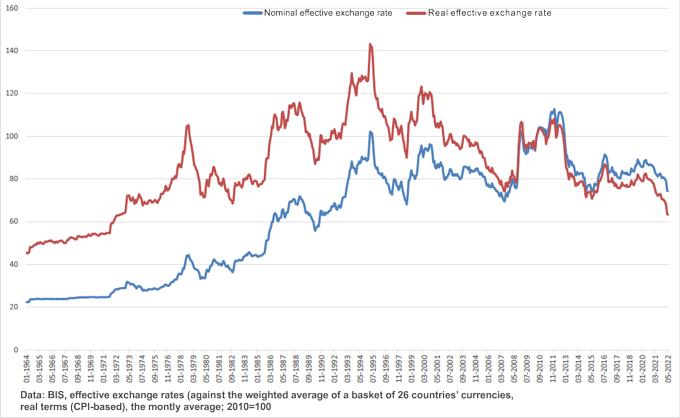
[Click to enlarge]
Here, in order to analyze the exchange rate trend from 2020 through 2022, we adopt the perspective of risk-averse investors by using a portfolio approach based on a theory that focuses on international financial transactions as a factor that determines exchange rates in the short term. This theory maintains that exchange rates are determined by (i) the differential between domestic and foreign interest rates, (ii) the expected future exchange rate and (iii) the risk premium. Figure 2 shows whether the change in the exchange rate is attributable to changes in those factors (Note 1).
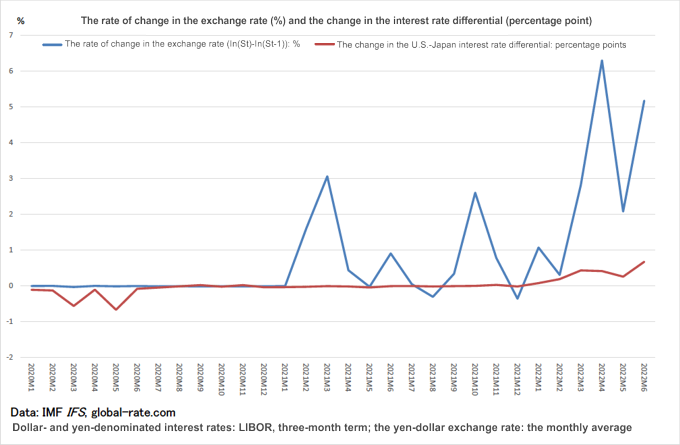
[Click to enlarge]
Figure 2 shows that only a small part of the recent change in the exchange rate is attributable to the change in the Japan-U.S. interest rate differential. In other words, most of the change in the exchange rate is attributable to the change in either the expected future exchange rate or the risk premium, or in both. Moreover, the change in the expected future exchange rate is presumably attributable in large part to expectations of a future widening of the Japan-U.S. interest rate differential. In short, the change in the expected future exchange rate reflects expectations about the difference in future monetary policy direction between Japan and the United States. On the other hand, the change in the risk premium is attributable to factors such as an increase in exchange volatility risk and a decline in risk tolerance against the volatility risk, and a change in the ratio of the balance of yen-denominated bonds to the balance of dollar-denominated bonds. Given the absence of a significant difference between Japan and the United States in the uptrend in the size of fiscal deficit or in the balance of government bonds, it can hardly be presumed that the change in the exchange rate is attributable to a change in the risk premium.
3. Yen Depreciation as Viewed in Terms of Industry-Specific Effective Exchange Rates
Next, let us look at the yen’s depreciation in terms of industry-specific real effective exchange rates. The factors behind a decline in a real effective exchange rate include (i) a fall in the nominal effective exchange rate, (ii) price falls, and (iii) a rise in foreign inflation rates. If Japanese products face intense competition with foreign products, product prices have to be lowered by reducing profit margins. If price declines occur in addition to a fall in the nominal effective exchange rate, the yen’s real effective exchange rate drops further. If we look at industry-specific real effective exchange rates (Figure 3) under these premises, with the same rate of change in the nominal effective exchange across industries, we recognize the presence of industries with relatively high or low real effective exchange rates. In industries where there is a relatively strong tendency to lower prices by reducing profit margins due to intense competition, the yen’s real effective exchange rate tends to decline as a result of price falls.
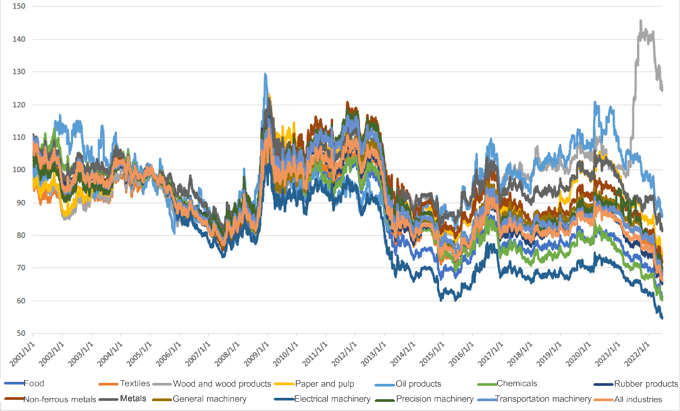
[Click to enlarge]
Table 1 shows changes in industry-specific real effective exchange rates as of June 30, 2022, compared with the beginning of 2020 and with the beginning of 2022. According to the comparison with the beginning of 2020, relative to the all-industry real effective exchange rate, the real effective exchange rates in the following sectors declined by a larger margin: food, textiles, paper and pulp, chemicals, rubber products, non-ferrous metals, general machinery, electrical machinery, and transportation machinery. Meanwhile, compared with the beginning of 2022, the real effective exchange rates in the food and transportation machinery industries declined by a larger margin relative to the all-industry real effective exchange rate. In particular, in the case of the transportation machinery industry, it is presumed that in addition to a decline in the nominal effective exchange rate, price falls implemented through the reduction of profit margins had a relatively large impact on the decline in the real effective exchange rate.

[Click to enlarge]
4.Yen Depreciation Viewed in Terms of the AMU Deviation Indicator
Finally, let us look at the yen’s value relative to other East Asian currencies in reference to the AMU and AMU Deviation Indicators. The AMU represents the weighted average of the exchange rates of a basket of East Asian currencies (the currencies of ASEAN+3 [Japan, China and South Korea]) against other major currencies (the U.S. dollar and the euro). The AMU Deviation Indicators measure changes in the relative values of the individual East Asian currencies in terms of changes in those currencies’ basket weights in the AMU since the base year (2000-2001).
Figure 4 shows the AMU’s exchange rates against the dollar, the euro, and the dollar-euro basket (the exchange rates weight-averaged by the shares of trade with the United States [65%] and the euro area [35%] in East Asia’s overall trade with the rest of the world). Although the AMU’s value was on an uptrend around the time of the global financial crisis, it has been trending downward since the end of 2012, falling sharply in 2022.
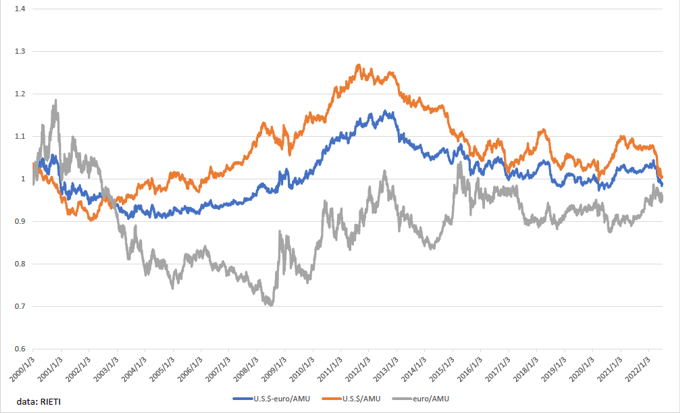
[Click to enlarge]
Figure 5 shows the trends in the AMU Deviation Indicators regarding the East Asian currencies. The trends have been asymmetrical among the East Asian currencies since 2008. Since the beginning of 2022, the Chinese yuan and the Indonesian rupiah have been on an uptrend, while the yen and the South Korean won have stayed relatively stable. On the other hand, the ASEAN currencies other than the Indonesian rupiah have depreciated significantly since 2020. In short, the yen has not necessarily depreciated relative to other East Asian currencies. In emerging countries into which capital tended to flow from the United States due to interest rate differentials when the FRB was implementing the zero-interest rate policy, capital outflows have occurred as a result of the FRB’s policy interest rate hikes, resulting in the significant depreciation of those countries’ currencies.
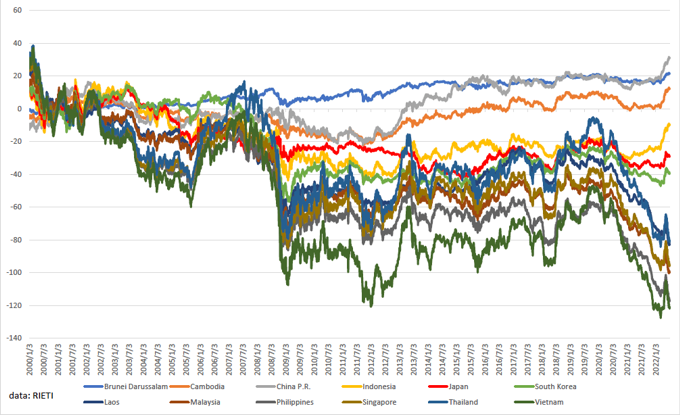
[Click to enlarge]
5.Summary
The yen’s recent depreciation is attributable in large part to the change in the future expected exchange rate (expectations of a future yen depreciation), rather than to the widening of the interest rate differential between Japan and the United States. The future expected exchange rate is presumed to reflect market participants’ expectations that the Japan-U.S. interest rate differential will continue to widen because of the difference in the monetary policy direction between the two countries.
From the industry-specific real effective exchange rates, it may be presumed that in the transportation machinery industry in particular, price falls due to the reduction of profit margins, in addition to the decline in the nominal exchange rate, has had a relatively large impact on the decline in the real effective exchange rate.
In terms of the AMU and the AMU Deviation Indicators, the weighted average of the East Asian currencies relative to the dollar and the euro has been on a downtrend since the end of 2012. Among the East Asian currencies, the yen has stayed relatively stable. The Chinese yuan has been trending upward against other East Asian currencies. Meanwhile, the ASEAN currencies have depreciated significantly. This suggests that capital is being withdrawn from emerging countries as a result of the FRB’s policy interest rate hikes.
Finally, careful consideration should be given as to which currency should be used as the benchmark for judging whether the yen’s value is falling. Relative to the all-industry exchange rate, industry-specific exchange rates for some industries are depreciating while the rates for other industries are not. Therefore, if foreign exchange market intervention is to be conducted as a countermeasure against the yen’s depreciation, it should be targeted at the all-industry exchange rate, rather than industry-specific exchange rates. On the other hand, given that the depreciation of emerging country currencies has become conspicuous, Japanese companies that have developed international production networks in East Asia should pay careful attention not only to the yen’s depreciation but also to the significant depreciation of the East Asian emerging countries’ currencies.


